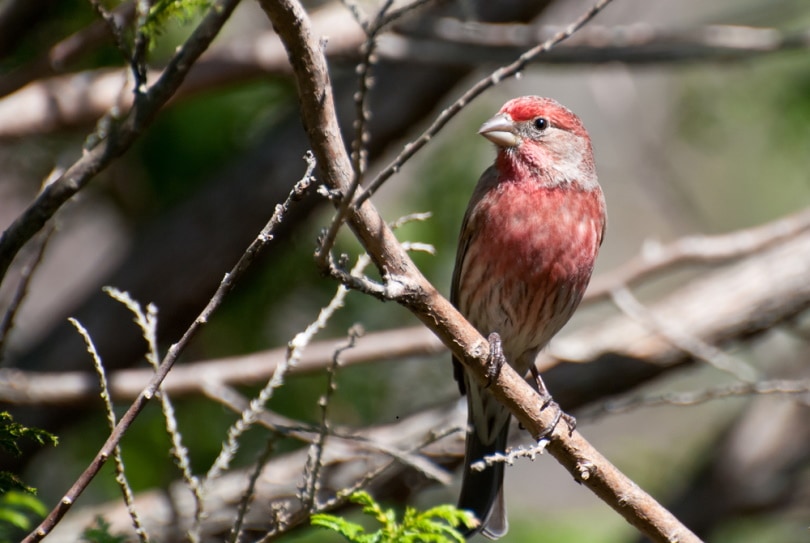Purple Finch vs House Finch: How Are They Different? (With Pictures)
Last Updated on

Finches are colorful birds that can be viewed throughout North America, especially in the U.S. Both the purple finch and house finch are admirable in their own ways and have beautiful plumages to accompany their similar shape and size. As they are finches, the purple and house finches are members of the Fringillidae family. Their colors are similar and difficult to tell apart. Those might be their similarities, but what makes them different? If you want to learn further about what makes these two bird species so special, keep reading below for detailed information about their characteristics, differences, and much more.

Visual Differences

At a Glance
- Origin: Southwestern North America
- Size: 4.7” to 6.3” long
- Lifespan: 10 to 14 years
- Domesticated: Yes
- Origin: Western North America
- Size: 5.1” to 5.5” long
- Lifespan: 11 to 12 years
- Domesticated: Yes

Purple Finch Overview

Characteristics and Appearance
The purple finch (Haemorhous purpureus) is a small bird that lives primarily in the forests and inhabited areas of the eastern and central United States. They also can be found out west, although their area is limited to the Pacific coast. Visually speaking, males of this species are covered with a reddish-purple array of feathers, as well as some brown features on their back and white on their bellies. However, female finches have a mix of browns and whites all over their bodies. Purple finches are plump birds in contrast to their tiny stature.
Typical Diet
Purple Finches are quite fond of seeds and prefer them over most other consumables. To gather their food, finches search the leaves close to their tree nests for nuts, fruits, or other seed-bearing vegetation. This makes them an easy bird to attract, as they will be drawn to any feeder that offers their favorite treats, especially black oil sunflower seeds.
Migration Pattern
Seasonal movements of a purple finch will vary in certain regions, but they live year-round in the northeastern U.S and along the western coast. Yet, in most central and southeastern states, the finches will migrate down from the colder Canadian climate after they’ve finished their breeding period. There are a few areas out west, such as Oregon, where they may mate as well.

House Finch Overview

Characteristics and Appearance
A house finch is a small finch with a slightly overlapping beak and a rounded head. A female or young finch is a brownish white variation, but a male will boast a deep red hue along with its head and breast. Generally, the house finch is accustomed to living in urban environments, which is evident in its name, but it can also be found in rural areas.
Typical Diet
The house finch has a diet similar to the purple finch, and it also prefers to crack open seeds rather than go for a meaty meal. Classic, black oil sunflower seeds are a perfect snack to bring the house finch to your backyard, even during the wintertime. Instead of being up in the canopy, house finches like to forage on the ground for their food, as well as get nectar from flowers. One interesting thing to note is that they stick to smaller seeds rather than large ones because they are easier to break.
Migration Pattern
The house finch is not a migratory bird, and they live year-round in all their known regions. These areas include a wide variety of habitats, and they can be found across the United States. But there is a portion of the central U.S that they tend to avoid, from North Dakota to Texas.
What Are the Differences Between Purple Finches and House Finches?
Purple Finches and House Finches look strikingly similar with their reddish bodies and small size. However, there are a few key things to look for if you want to identify them correctly. One of the easiest ways to tell them apart is by their head and bill shape. The head and bill of a house finch are rounder and perhaps larger in comparison to its purple cousin. The purple finch also has a hint of purple (hence the name) in its plumage that extends further on the back of its body. Still, these variables can be a challenge to pick out if you aren’t able to get a close look. Also, keep in mind that those who live in the midwestern states are seeing house finches since the purple finch isn’t found in the region.

Which Finch Do You Like the Most?
The house finch and purple finch are both a delight to see at the feeder due to their beautiful colors and pleasant songs. However, some may prefer the look of one over the other, even if the differences aren’t so obvious. As we mentioned earlier, those who live in the midwestern U.S will only be able to enjoy the house finch. It’s all up to which one you prefer, but neither is a bad choice!
Featured Image Credit: (L) simardfrancois, Pixabay | (R) bryanhanson1956, Pixabay
Table of Contents
About the Author Robert Sparks
Robert’s obsession with all things optical started early in life, when his optician father would bring home prototypes for Robert to play with. Nowadays, Robert is dedicated to helping others find the right optics for their needs. His hobbies include astronomy, astrophysics, and model building. Originally from Newark, NJ, he resides in Santa Fe, New Mexico, where the nighttime skies are filled with glittering stars.
Related Articles:
Monocular vs Telescope: Differences Explained (With Pictures)
10 Types of Hummingbirds in Arkansas (With Pictures)
8 Types of Hummingbirds in Nebraska (With Pictures)
5 Types of Hummingbirds in Idaho (With Pictures)
3 Types of Hummingbirds in Mississippi (With Pictures)
8 Types of Hummingbirds in Kansas (With Pictures)
5 Types of Hummingbirds in West Virginia (With Pictures)
5 Types of Hummingbirds in Ohio (With Pictures)
